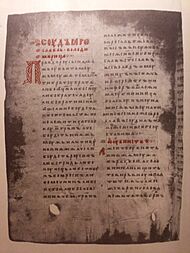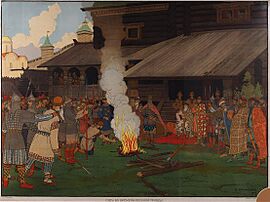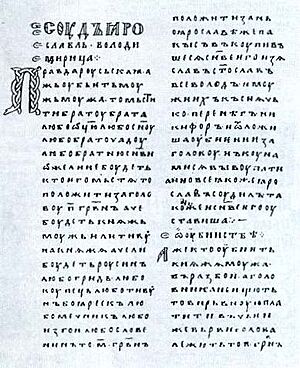Russkaya Pravda facts for kids
Quick facts for kids ''Russkaya Pravda'' |
|
 First page of the oldest surviving copy of the Russkaya Pravda (Extensive edition) from Synodic Kormchaia of 1282 (Novgorod)
|
|
| Created | From the beginning of the 11th century |
| Authors | Prince's administration |
| Purpose | Guidance for the princely court |
The Russkaya Pravda was a very old set of laws from a place called Kievan Rus'. This was a big area in Eastern Europe a long time ago. It helped guide courts and keep order.
It started around the early 1000s with laws from Prince Yaroslav the Wise. Over many years, new rules were added to it. The Russkaya Pravda was the main source of law for Kievan Rus'.
Unlike many laws at the time, it was very different from the laws of the Byzantine Empire. It did not include punishments like death or physical harm. This was quite unusual for that time. Some historians think this might show ideas from Norse laws.
Contents
Different Versions of the Laws
There are three main versions of the Russkaya Pravda that we know about. These are the Short Edition, the Extensive Edition, and the Abridged Edition.
More than 110 copies of these laws still exist today. They were written down between the 1200s and the 1700s. These copies are found in different old books and records. Most of the copies, including the oldest ones, are from the Extensive Edition.
A historian named Vasily Tatischev found this important law book. He discovered it in an old record from Novgorod. In 1738, he shared it with the Russian Academy of Sciences. The first printed version with notes was published in 1767 by August Ludwig von Schlözer.
How the Laws Developed Over Time
The rules in the Russkaya Pravda changed as society in Rus' changed. They were based on common traditions, laws made by the knyaz (prince), and court decisions.
The Short Edition of the Russkaya Pravda has two main parts. One part is called Yaroslav's Law, which came out around 1017. The other part is called The Law by Yaroslav's Sons, from about 1054. Some parts might have been added even later.
Yaroslav's Law included rules for the feudal system. This was a system where land was exchanged for loyalty and service. It also had older rules from even earlier times. One idea is that this law was made to help solve a fight in Novgorod.
The Russkaya Pravda continued to grow and improve. This happened during the time of Yaroslav's sons and his grandson, Vladimir Monomakh. New rules were likely added after big protests in cities like Kiev and Novgorod around 1068–1071.
Much later, in 1497, the Russkaya Pravda was replaced. A new set of laws called the Sudebnik was created for the growing Russian state. Before that, new laws were also made in cities like Pskov and Novgorod.
What the Laws Covered
The Law by Yaroslav's Sons made communities more responsible. For example, if a prince's soldier or servant was killed in a community's area, that community would face serious consequences. It also had strict punishments for setting fires and for groups of people trying to take rich people's belongings. After a big riot in Kiev in 1113, a law was added to limit how much money lenders could charge in interest.

The Russkaya Pravda helped set up the system of feudal society and social differences. Between the 1000s and 1200s, it created new laws for different groups of people. These included smerds (peasants who depended on a lord) and zakups (peasants who worked to pay off a loan). It also had rules for kholops, who were like slaves. The Extensive Edition had special rules about zakups and kholops.
The laws also showed the growing power of the prince's court. They created many different types of punishments and fines. These fines often went to the prince or his officials. Victims would get less money as compensation.
The Pravda tried to stop blood feuds, which were common at the time. A blood feud was when families would seek revenge for a killing. The law limited who could get revenge to only the closest family members. If there was no one to get revenge, the killer had to pay a fine to the prince. They also had to pay some money to the victim's family. If a woman was killed, the fine was half the usual amount.
The laws also protected the health and honor of free people. They offered money if someone was insulted or harmed. The Pravda had many rules for stealing, damaging forests or land, and going onto someone's property without permission. It also dealt with debts between people and rules about who inherited property.
To decide if someone was guilty, the Pravda used witnesses and oaths. Sometimes, they even used a "trial by ordeal," like a test with water or iron. This was a last resort to prove if someone was innocent or guilty. The legal process also included gathering evidence and chasing after criminals. Investigators also had to check for false accusations.
See also
- Byzantine law
- Nomocanon
- Zakon Sudnyi Liudem
- Kormchaia
- Merilo Pravednoye
- Church Statute of Prince Vladimir
- Church Statute of Prince Yaroslav
- Pravosudiye Mitropolichye
- Statutes of Lithuania
- Sudebnik of 1550
- Stoglav
- Sobornoye Ulozheniye
- Poljica Statute
- Law code of Vinodol


